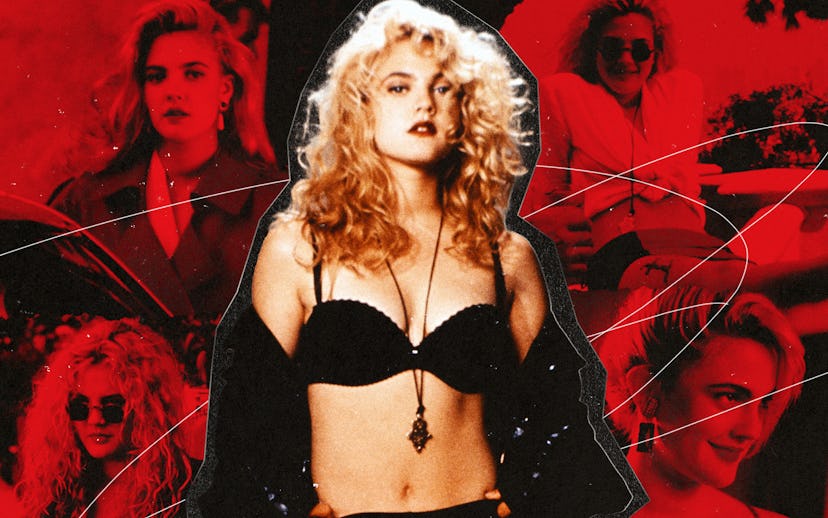
Fashion
Drew Barrymore In Poison Ivy Is Your ‘90s-Inspired Villain Era Aesthetic
A masterclass in the grungy yet glamorous hot girl style of the time.
The 1992 erotic thriller Poison Ivy gave Drew Barrymore one of her first major roles as a teenage actress, but by that point, she’d already lived through more than most people twice her age. Born into a famous family, Barrymore was a star since she was a small child and then publicly went through the wringer of excessive partying and drug addiction that so often comes with getting very famous at a very young age, as detailed in her memoir, Little Girl Lost, published two years before Poison Ivy was released.
Poison Ivy, which also holds the distinction of being one of the very few films of the late ‘80s to early ‘90s erotic thriller boom directed by a woman, plays on Barrymore’s well-known “bad girl” persona while also being a surprisingly potent depiction of teenage class differences and the queerness of female friendships that turn into obsessions. As the devious yet tragic Ivy, a mysterious lower-class girl who develops an intense, drama-filled friendship with the upper-class Sylvie (Sara Gilbert), Barrymore gives a masterclass in the grungy yet glamorous hot-girl style of the time.
As is so often the case in teen stories, Ivy and Sylvie’s contrast in personalities is expressed through their outfits. Sylvie may come from wealth, but she doesn’t dress in flashy designer clothes. Instead, she opts for cozy oversized T-shirts and long dresses so as not to call attention to herself — lightly alternative (a yin and yang T-shirt she wears could easily be pictured on Billie Eilish’s vision board) but not edgy enough to ruffle any feathers. Ivy is the opposite, with a dangerous edge to her leather jackets, crop tops, and skirts cut short enough to reveal a tattoo on her thigh. She unapologetically dresses to look sexy, something that Sylvie can’t imagine doing herself.
Ivy’s sartorial mix of femininity and hard rock brings to mind her small-screen contemporary Kelly Bundy from the sitcom Married… with Children and anticipates the goth-meets-bohemian swagger of Rayanne Graff from My So-Called Life. It’s no coincidence that all of these essential early ‘90s bad-girl characters are meant to be lower-class. All of their styles are a hodgepodge — with no money for designer clothes, their outfits are meant to signify their savviness with a mixture of thrift-store finds, hand-me-downs, and pieces that may well have been shoplifted or pilfered from an ex. These characters feel like cool girls you’d run into in the pit at a rock show, and given her sheltered upbringing, it’s easy to see why Sylvie would find herself obsessing over Ivy, as her style represents the freedom that Sylvie feels she lacks.
In true erotic thriller fashion, Poison Ivy takes some wild narrative turns. The film becomes a gender-swapped take on the Oedipus myth, with Ivy seducing Sylvie’s father, Darryl (Tom Skerritt), and killing her mother, Georgie (Cheryl Ladd). Ivy’s style captivates Sylvie’s parents nearly as much as it does Sylvie. The sight of Ivy in a tied-up blouse instantly attracts Darryl’s sleazy attention, and as Ivy becomes closer and closer to the family, she goes from sharing clothes with Sylvie to freely borrowing clothes from Georgie, whose wardrobe is filled with tailored, elegant pieces that might typically read as a stuffy rich lady. On Ivy, however, they instantly become tools of subversion. By wearing Georgie’s clothes, Ivy is able to shift from a tough girl from the streets to a femme fatale.
In Georgie’s flowing red trench coat, Ivy looks like a film noir vixen, but Barrymore’s Valley girl cool makes the character feel thoroughly modern. Barrymore brought a sense of playfulness that inspired her red carpet looks throughout the ‘90s, and Poison Ivy feels like a perfect synthesis of what made her a fashion icon during that decade, merging grunge, sexiness, and classic Hollywood into looks so powerful they literally have the ability to break up a family.
Ivy is more than just a villain, and her twisted behavior arises from a desire to be loved and find some form of connection at any cost. She knows how to use fashion to get what she wants because she has no other choice. Just like the actress who played her, Ivy grew up too fast. Her outfits help in her mission to seduce and destroy, but ultimately even a leather jacket or a gorgeous dress can’t save her.
This article was originally published on